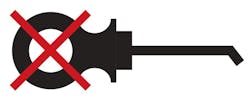No Dipsticks Allowed: A Guide to Transmission Services Without Dipsticks
Out with the old, and in with the new.
“Oil pressure up, checking transmission fluid (pulls dipstick and stares at it for a few seconds). Transmission fluid level full.” Remember the good ol’ days — the easy life. It was 5W-30 vs. 10W-30, pushing the button on the Honda instrument panel with the key to reset the oil change indicator and pulling a dipstick to check the fluid level of a transmission. These quick and simple procedures made life fun in the service bay. Now we have to check viscosity and an alphabet soup of standards (API, ILSAC, ACEA), look up a slew of videos and manuals to reset the oil light and, you guessed it, transmission dipsticks have found their way out of the engine.
For years, several manufacturers have begun removing the transmission dipstick and replacing the drain plug with a combination drain plug and standpipe. If you can imagine, a straw or snorkel tip comes up from inside the drain hole to a level just above the appropriate fluid level in a transmission. If you were to remove that drain plug, the excess fluid would drain out of the plug, leaving the transmission fluid level just right. Just like a simple differential check.
But wait, there’s more!
Remember the cross-stitch on good ol’ transmission fluid dipsticks. The cross-stitch area was there to allow you to read the fluid level without compensating for temperature because transmission fluid expands when hot and alters the level inside the transmission. The issue is that a standpipe inside a transmission pan cannot account for the level of the transmission fluid with varying temperatures. The example we will use today is the Toyota 2007 and up six-speed transmission for front-wheel drive. According to Toyota, the ideal time to inspect the transmission fluid level is when the temperature of the fluid is between 104 and 113 F. You are generally checking the fluid level in your shop that is around 190 F.
Most manufacturers with this style of standpipe system will have you adjust the temperature of the fluid (perhaps park it for a bit). Toyota has come up with a special group of tools to help you check the fluid levels in their vehicles. And the price for these tools is just as ugly as the procedures to use these tools in your shop. In this instance, we will be referencing the Toyota TSB 0036-13 for a variety of vehicles years 2007-2013.
Safety First
These procedures will require you to do a few things that will make your risk manager or insurance company start looking for the key to the liquor cabinet. You will need to access parts inside a wheel well while the engine is on, remove plugs and attach tools on a running engine and remove fluid that is 190 F. So please let’s make sure all our body parts stay in the same shape and condition that they were before the service started! That means, wear your safety glasses, burn sleeves, gloves and restrain the vehicle by suspension, blocking or emergency brake.
Tools
To correctly perform these procedures, you will need:
- Trim clip removal tool
- Socket set
- 6 mm hexagon socket wrench
- Scan tool with techstream installed
- ATF leveling gauge kit
- Vacuum regulator manifold
- Transmission fill adapter
- Fluid extraction tank
- Transmission fill system
Fluid Check Procedures
- Install the scan tool, start the vehicle and look for the transmission temperature. The fluid temperature should be between the 185- and 194-degree marks with an idle of 600 to 800 rpms.
- Remove the bolts and clips from the front fender well on the driver’s side, and locate the transmission fill plug; remove it. The OEM plug will have a “WS,” which stands for world standard. This is easier to be accessed if the vehicle is on a lift.
- Install the transmission fill adapter (hand tight) into the fill hole.
- Attach the vacuum regulator manifold to the fill adapter.
- Attach the vacuum regulator manifold to the fluid extraction tank and connect the shop air supply to the manifold (ensure that the shop supply does not exceed 100 psi).
- Open both the upper and lower valves, and set your regulator between 2 and 5 in. Hg.
- Locate the transmission drain plug, and remove the plug. Fluid will not drain if the vacuum on the system remains.
- Install the level gauge (hand tight) into the drain plug, and adjust the gauge to the proper height as specified by the temperature and rpms inside the bulletin. This will extend the level of the standpipe to the appropriate level, given the operating conditions.
- Turn off the vacuum to the transmission, and determine if fluid comes out of the level gauge.
If fluid drains out, the transmission was overfilled. Allow it to drip dry. If fluid does not come out, this means that either the fluid level is low or just right. You will need to add transmission fluid to determine which scenario is correct.
Fluid Fill Procedures
- Remove the vacuum regulator quick connect from the transmission fill adaptor.
- Connect the transmission fill system to the transmission fill adaptor.
- Add fluid until fluid begins to drain from the level gauge.
- Stop adding fluid, and allow the level gauge to drip dry.
- Remove the transmission fill system from the transmission fill adaptor.
Reinstalling The Plug
You must now reverse your steps to finish your transmission fluid level check.
- Install the vacuum manifold and fluid extraction system to the transmission fill adapter.
- Connect air and set gauge between 2-5 in. Hg. and open both valves.
- Bring the leveling gauge back to the beginning height, and remove it from the transmission drain hole.
- Reinstall the drain plug to torque specs.
- Turn off the air supply, and remove the fluid extraction system, vacuum manifold and transmission fill adapter.
- Install the transmission fill plug to torque specs.
- Install fender well, lower vehicle, disconnect the scan tool and turn off the engine.
Should We Even Be Doing This?
It is the opinion of many on the AOCA Talk, that because of the amount of time and money to complete this service, it should not be a normal part of your service routine. Fluid level in this scenario should only be serviced if there is an obvious leak, performance issues or a service on the transmission is being done. And due to the fact that this procedure can take up to 20 minutes and the cost of this equipment can set you back over $1,000, you may also consider if you should charge the customer just to check the fluid on the transmission.
The battles we lose to the dealership are due to the inability for our industry to keep up with the growing technical challenges produced by today’s OEMs. While this is a small change in the way we process a vehicle, more and more adjustments are made to force you into saying either “We don’t do that,” or, hopefully, “Of course, we can do that.” The key is education and communication. Take the time to understand what this will do for your shop(s) today and down the road. Make the plan on how you will address this issue, and be prepared to communicate with your shop and your customers on what should be done.
All of us old-timers miss the good ol’ days with easy procedures, quick turnarounds and simple products. Manufacturers are not making those vehicles anymore, and our customers are not driving them anymore. The transmission service is a huge reminder of these current times. This very expensive and timely procedure is just one of the many changes happening in our shops. Your business plan has to take into account what is changing in technology with your customer’s vehicles and how you are going to help them.
About the Author

Lenny Saucier
LENNY SAUCIER has been serving the automotive aftermarket and its future leaders since 2000. He serves as director of retail training at Fullspeed Automotive. He can be reached at [email protected].
